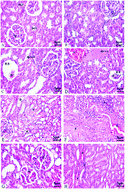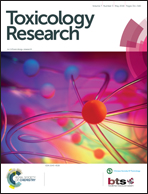Beneficial effects of folic acid on the kidneys and testes of adult albino rats after exposure to methomyl†
Abstract
The aim of this study was to evaluate the protective effect of folate against methomyl-induced toxicity on the kidneys and testes of male rats. Adult male albino rats were divided into four groups; Group I served as the control (vehicle), Group II received folic acid (1.1 mg per kg b.wt.), Group III methomyl (1 mg per kg b.wt.) and Group IV folic acid and methomyl. Treatments were administered via oral gavage on a daily basis for 14 weeks. Thereafter blood samples were collected and serum creatinine, testosterone and total antioxidant capacity (TAC) were determined. Animals were sacrificed and semen analysis was conducted. The kidneys and testes were excised and malondialdehyde (MDA) levels were determined. Histopathological and immunohistochemical analyses for caspase-3 were also undertaken. Methomyl treatment resulted in a significant (p < 0.001) elevation of creatinine and MDA levels and significant (p < 0.001) reduction in testosterone and TAC levels. Furthermore, methomyl caused a significant (p < 0.001) reduction in sperm quality. Histopathological examination indicated testicular and renal damage with strong immunoreactivity for caspase-3. Functional and tissue damage was prevented in rats treated with a combination of methomyl and folic acid. This is ascribed to the ability of folate to directly scavenge reactive oxygen species and indirectly enhance cellular redox homeostasis. This study identified that folic acid supplementation may have a beneficial effect in preventing or reducing the deleterious effects of methomyl exposure on kidney as well as testis structure and function. Future studies should focus on the fertility outcome/pregnancy index in rats.



 Please wait while we load your content...
Please wait while we load your content...